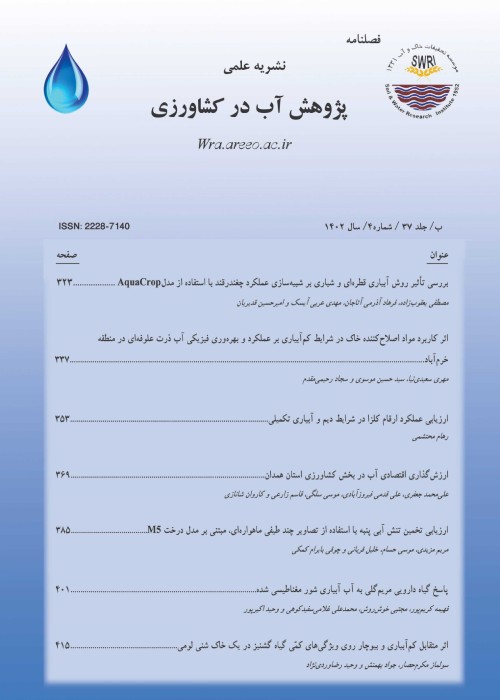Effect of Salinity Stress on Some Biochemical Characteristics Four Genotypes of Almond (Prunus dulcis)
Author(s):
Article Type:
Research/Original Article (دارای رتبه معتبر)
Abstract:
Scion-rootstock combination and level of salinity affect on the biochemical characteristics of almond cultivars. To evaluate the effect of salinity stress on the biochemical reactions of almond cultivars and genotypes, a factorial experiment was carried out based on completely randomized design (CRD). Treatments included two factors: Factor A: genotypes in four levels (Shokofeh,Sahand cultivars, and 13-40 genotype budded on GF677 rootstock, and GF677 (without budding)), and Factor B: irrigation water salinity in five levels (0.5, 2.5, 4.9, 7.3 and 9.8 dS/m) .Total phenolic, antioxidant capacity, soluble carbohydrate, non-soluble carbohydrate, proline, total soluble proteins, hydrogen peroxide, malondialdehyde, other aldehydes, enzymes activity of catalase, ghayacol peroxidase and ascorbat peroxidase were measured at the end of the experiment. Results showed that, in all genotypes, with increasing salinity level (up to 9.8 dS/m) the content of hydrogen peroxide, malondialdehyde and other aldehydes was increased. Also, the content of total phenolics, antioxidant capacity, soluble carbohydrate, proline, total soluble proteins, enzymes activity of catalase, ghayacol peroxidase and ascorbat peroxidase were higher at the lower salinity levels (2.5 and 4.9 ds/m), but their contents were reduced in higher salinity levels. Overall, the highest content of soluble proteins, enzymes activity of catalase, ghayacol peroxidase and ascorbat peroxidase were recorded at salinity level of 7.3 dS/m, and the highest content of total phenolics, antioxidant capacity, soluble carbohydrate and prolin at salinity level 9.8 dS/m were observed in Shokofeh cultivar. Also, at salinity levels of 7.3 and 9.8 dS/m, the lowest content of hydrogen peroxide, malondialdehyde, other aldehydes, and total non-soluble carbohydrate were observed in Shokofeh cultivar. Finally, Shokofeh and Sahand budded on GF677 rootstock were recognized as the most tolerant and sensitive cultivars to salinity, respectively.
Keywords:
Language:
Persian
Published:
Journal of Water Research in Agriculture, Volume:32 Issue: 2, 2018
Pages:
201 to 215
magiran.com/p1870899
دانلود و مطالعه متن این مقاله با یکی از روشهای زیر امکان پذیر است:
اشتراک شخصی
با عضویت و پرداخت آنلاین حق اشتراک یکساله به مبلغ 1,390,000ريال میتوانید 70 عنوان مطلب دانلود کنید!
اشتراک سازمانی
به کتابخانه دانشگاه یا محل کار خود پیشنهاد کنید تا اشتراک سازمانی این پایگاه را برای دسترسی نامحدود همه کاربران به متن مطالب تهیه نمایند!
توجه!
- حق عضویت دریافتی صرف حمایت از نشریات عضو و نگهداری، تکمیل و توسعه مگیران میشود.
- پرداخت حق اشتراک و دانلود مقالات اجازه بازنشر آن در سایر رسانههای چاپی و دیجیتال را به کاربر نمیدهد.
In order to view content subscription is required
Personal subscription
Subscribe magiran.com for 70 € euros via PayPal and download 70 articles during a year.
Organization subscription
Please contact us to subscribe your university or library for unlimited access!


